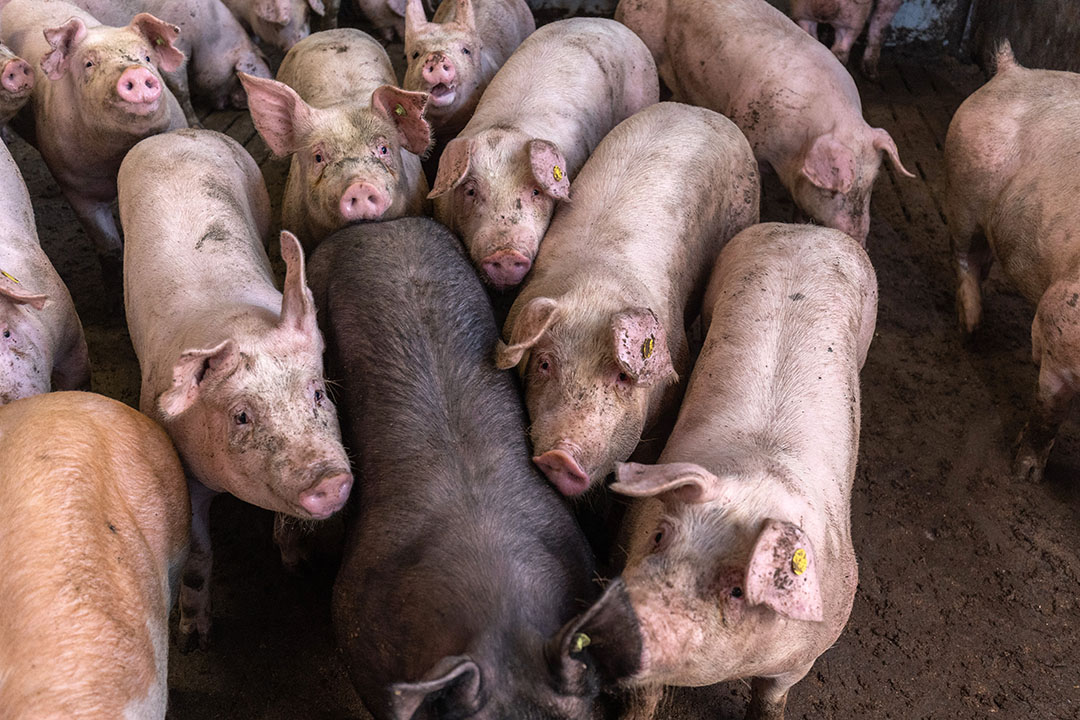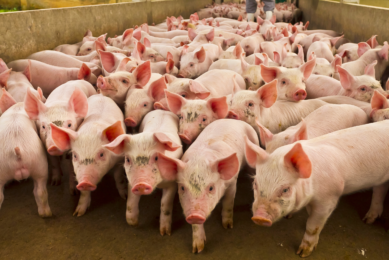Swine highlights from the ASAS 2022 meetings

The meeting of the American Society of Animal Science (ASAS) 2022 was held 26–30 June in Oklahoma City, OK, USA. The meeting was held with the Canadian Society of Animal Science and brought together researchers, students and the allied industry from all over the world involved in the different animal science specialties.
Swine related topics at ASAS 2022
Traditionally, this meeting lacked the presence of many swine-related abstracts and researchers. The reason for this is that those would appear at the Midwest ASAS meetings in spring. However, to draw more swine professionals to the forum, ASAS president Dr Mike Tokach of Kansas State University (KSU) said various steps had been taken, including condensing the swine-related sections into 2 days.

Physiology and endocrinology
Research presented by Shannon Dierking and others of South Dakota State University, USA, characterised the changes in vaginal epithelium, vaginal mucus and anogenital distance related to reproduction during gilt development as a potential opportunity to develop an on-farm test to detect early puberty in gilts. The researchers are hoping to find a biomarker to screen gilts as early as day 160. This would aid the decision to cull or keep them before they are overweight for the standard finisher hog market or are sold as low-value cull sows if they do not breed. Further research is needed.
Boar taint
Research by a team led by Dr Christine Bone at the University of Guelph, ON, Canada, focused on predicting early versus late-maturing boars. This related to boar taint for intact males raised for slaughter; today’s standard practice is to castrate males early in life. The researchers found a moderate positive correlation in plasma samples taken at day 21 and 28 of age to boars’ fat levels of estrone sulphate, but not sufficient to accurately predict the early maturation of the boar or the resulting boar taint at puberty. The researchers are hoping to find a successful biomarker pattern to genetically select boars in the future to be void of boar taint at ideal slaughter weights or create a tool to determine the best weight to harvest intact males that do not impact consumer perceptions.
Animal behaviour and well-being
The presentations featured swine research on a variety of topics, from transportation and slaughter to farmer worker surveys on euthanasia. Work from the University of Georgia by Daniela A. Alambarrio further evaluated vibrations that pigs endure during transport in the summer. Vibration levels for human safety are defined, but there has been little guidance for livestock species. Results indicated that all the compartments on a straight double-deck trailer exceeded the values that would be likely to cause injury in humans. The bottom deck experienced more vibration than the top deck, and placement in either the front, middle or rear had little influence on vibration in either deck.
Alginate hydrogel beads
Research from Texas Tech University presented by Emerald Julianna Salinas discussed the role of supplementing finishing pigs with alginate hydrogel beads during transportation on stress, hydration and behaviour. The pigs given the beads during transportation seemed to remain calmer by lying more and drinking less after transport than the control pigs, indicating that the electrolytes given to the pigs via the beads helped maintain hydration during transportation.
Comparative gut physiology
This session covered several topics about the calcium-sensing receptor through the intestinal barrier and repair in all species. Dr Chengbo Yang from the University of Manitoba started the session by discussing his laboratory’s work on calcium. The work demonstrated that L-tryptophan or alpha-casein could induce the secretion of gut hormones through the regulation of the Calcium Sensing Receptor (CaSR), suggesting that specific feedstuffs in wean pig diets can influence the intestinal barrier function in pigs.
Additionally, Dr Amanda Ziegler from North Carolina State University (NCSU) discussed her use of the suckling pig to improve neonatal gastrointestinal health across all species. During her presentation, she discussed the age-dependent defects in barrier function and how potentially a prebiotic can aid neonates’ barrier function.
Dr Douglas Burrin (USDA-ARS Children’s Nutrition Research Center), a researcher who has used the pig as a model for neonatal human nutrition, finished the session by discussing his work on the importance of colostrum, regardless of species, on the prevention of necrotising enterocolitis (NEC). He suggested opportunities for livestock species to use colostrum products to help improve survivability and human nutrition.
Animal breeding and genetics
Dalton R. Obermier of the University of Nebraska-Lincoln used the NuTracks animal monitoring system to better understand the impact of sire estimated breeding value on growth and feed intake, as feed intake and efficiency are significant drivers in the economics of swine production. Interestingly, pigs classified genetically as high feed intake and high gain travelled less distance and tended to lie more, suggesting larger meal sizes or longer time at the feeders for their nutritional needs. Also, pigs classified as low feed intake and low gain had a greater loin eye area and were leaner than the other sire groups.
Another swine-related presentation by Dr Gary A. Rohrer (USDA) focused on understanding the role of the number of teats and its correlation to the number of vertebrae a pig has, which was found to have a genetic correlation of approximately 0.21. Interestingly, genetic traits for weight did not correlate with vertebra traits.
Non-ruminant nutrition
In his awarded talk, Dr Phillip Miller discussed the work of the National Animal Nutrition Program, a NASEM-funded committee, on the future role of establishing a living database and approach for better understanding of nutrient requirements and ingredient composition.
Additionally, Jamil Faccin (KSU) presented a follow-up to a vitamin premix survey. In this survey, researchers represented approximately 50–70% of the USA swine industry depending on the life stage. This was almost double the number of animals in their 2016 survey. Similar to their original findings, producers are formulating the majority of vitamins two to nine times higher than NRC 2012 recommendations for reproductive animals but have lowered their safety margins in finisher pigs, except for vitamin D and K. They also compared levels of vitamins across China, Brazil and the USA. For instance, the USA tended to have higher inclusions of riboflavin than China or Brazil for multiple production phases. This data is essential in benchmarking levels and aiding in experimental design, but there is still more to understand about the variation between producers, nutritionists and/or countries.
Interestingly, on behalf of Laval University in Québec, Canada, Mohamed Ali Ketata presented on the impact of feeding high levels of copper and zinc on digestibility minerals. The results were contradictory to the literature: high levels of copper and zinc reduced apparent total tract digestibility (ATTD) and apparent ileal digestibility (AID) of calcium but increased phosphorus ATTD. The researchers suggested they need to understand the phytic phosphorus levels of the diets better to understand these findings.
Digestibility of calcium and phosphorus
Throughout his career, Dr Layi Adeola has researched the digestibility of calcium and phosphorus in swine and poultry. He highlighted the findings that calcium vs phosphorus digestibility as a type of digestibility or location of sampling (total tract versus ileal) differs depending on the species and potentially the ingredient.
Feed restriction before slaughter has been an area of interest for producers in attempts to maximise yield and hot carcass weight. New research from KSU by Hilario Cordoba and others indicated that removing feeding for only 12 hours preharvest (versus 24 hours) maximised hot carcass weight, which supports earlier research trials.
Maryane Sespere Faria de Oliveira of the University of Illinois presented digestibility research on a new bacillus strain, Bacillus toyonensis M15750 and found that it has the potential to improve AID of dry matter, gross energy and starch.
More on non-ruminant nutrition
Dr Candido Pomar presented his ongoing research at Agriculture and Agri-Food Canada regarding precision feeding via specialty feeders that deliver specific rations to individual pigs. Using his research, he indicated that the actual problem of precision feeding is that it is possible to address only the body weight variation of pigs. To truly optimise performance, researchers also have to address the metabolic variability of the animal. Glucose is an excellent example of this phenomenon, as animals can have similar body weight and similar glucose levels, but one could be considerably leaner than the other animal.
Dr Ruurd Zijlstra, University of Alberta, AL, Canada, discussed the balance between digestibility and the need for fibre components to optimise gut health and the immune system. An example he used during his presentation was the production of butyrate from hindgut fermentation of fibre components and its role beyond being an energy source for enterocytes. It goes through the portal vein and would then be involved in the entire immune system.
Marcos Duarte (NCSU) continued the symposium by discussing the role of protein and feed additives in altering the microbiome. He also discusses the opportunities for nutritional interventions, such as lower crude protein diets in wean pigs.
Dr Dean Boyd – also awarded – brought a different perspective that the swine industry is missing about lower crude protein diets, in which crystalline amino acid replaces soybean meal: ultimately, it is not a more sustainable option. For instance, feeding higher levels of soybean meal when whole body weight is the same and there is a similar carcass food conversion ratio (FCR), higher levels of soybean meal result in 27% less CO2 emissions. This further drove home the point of all the presentations that the balance of precision feeding, sustainability and optimal animal health is still not perfect.
Ellen Davis, Arm & Hammer, discussed the traits of Escherichia coli and the key differences between pathogenicity and virulence of the E. coli strains. One unique feature determining the virulence of the strain is the ability of E. coli to use horizontal gene transfer to evolve and the fact that antimicrobial resistance is rarely on the chromosome but via plasmids. Future strategies need to consider these robust evolutionary abilities as we evaluate nutritional strategies, such as pharmacological levels of zinc.
This presentation was followed by Gilles Langeoire of Langeoire Consulting from France, discussing the European perspectives of feeding low zinc diets through using highly digestible proteins and acidification of the diets.
Dan Bussières, Cérès, discussed nutritional interventions from a field perspective in Canada. He presented about acidification and optimising acidification and insoluble versus soluble fibre sources to prevent post-weaning diarrhoea in diets void of pharmacological levels of zinc.
Kyle Coble, JBS USA, discussed the lessons learned in dealing with E. coli within their system. Some key points discussed were the need for a quantitative versus qualitative approach to evaluating the severity of post-weaning diarrhoea by using dry matter versus faecal scores. Additionally, nutritional strategies to fight diarrhoea cannot be off-the-shelf products, but tailored solutions by sow farm flow.











